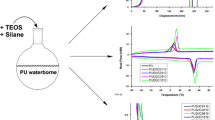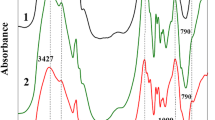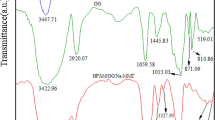Abstract
We studied the effect of variations in the composition of the 3D polymer matrix on the water adsorption properties of poly(N-isopropylacrylamide-co-acrylamide) [abbreviated as poly(NIPAAm-co-AAm)]-based gels containing fillers of diverse hydrophilicities (Na-montmorillonite and hydrophobized montmorillonite). The hydrophilicity of the polymer matrix was modified by varying the ratio of the initial monomers, since acrylamide (AAm) is hydrophilic, whereas N-isopropylacrylamide (NIPAAm) is relatively hydrophobic. Filler content was varied in the range of 1–25 wt%. The water content of polymers, fillers and composites, a parameter determined by their different hydrophilicities was characterized by gravimetry and/or thermoanalytical methods (TG, DSC). The water content of the samples was found to be controllable by varying the hydrophilicity of the polymer matrix and/or the amount and hydrophilicity of the fillers added. Swelling of the relatively hydrophobic poly(NIPAAm) can be increased by the addition of hydrophobic fillers, whereas that of the hydrophilic poly(AAm) can be enhanced by the addition of hydrophilic fillers. The effect of changes in composition on the desorption enthalpies of the samples was determined. The water content of the copolymer increases with increasing the ratio of the hydrophilic monomer, which is due to an increase in the so-called free water content. In the case of the hydrophobic poly(NIPAAm) it is primarily hydrophobic association interactions that dominate the interaction between the polymer matrix and the lamellae of the filler, whereas in the case of the hydrophilic poly(AAm) hydrophilic interactions are dominant.







Similar content being viewed by others
References
Tian Q, Zhao XA, Tang XZ, Zhang YX. Fluorocarbon-containing hydrophobically modified poly(acrylic acid) gels: gel structure and water state. J Appl Polym Sci. 2003;89:1258–65.
Shin BC, John MS, Lee HB, Yuk SH. pH/temperature dependent phase transition of an interpenetrating polymer network: anomalous swelling behavior above lower critical solution temperature. Eur Polym J. 1998;34:1675–8.
Yin L, Fei L, Cui F, Tang C, Yin C. Superporous hydrogels containing poly(acrylic acid-co-acrylamide)/O-carboxymethyl chitosan interpenetrating polymer networks. Biomaterials. 2007;28:1258–66.
Alexandre M, Dubois P. Polymer-layered silicate nanocomposites: preparation, properties and uses of a new class of materials. Mater Sci Eng. 2000;28:1–63.
Ray SS, Bousmina M. Biodegradable polymers and their layered silicate nanocomposites: in greening the 21st century materials world. Prog Mater Sci. 2005;50:962–79.
Shibayama M, Suda J, Karino T, Okabe S, Takehisa T, Haraguchi K. Structure and dynamics of poly(N-isopropylacrylamide)-clay nanocomposite gels. Macromolecules. 2004;37:9606–12.
Shibayama M, Karino T, Miyazaki S, Okabe S, Takehisa T, Haraguchi K. Small-angle neutron scattering study on uniaxially stretched poly(N-isopropylacrylamide)-clay nanocomposite gels. Macromolecules. 2005;38:10772–81.
Haraguchi K, Li HJ, Matsuda K, Takehisa T, Elliott E. Mechanism of forming organic/inorganic network structures during in-situ free-radical polymerization in PNIPA-clay nanocomposite hydrogels. Macromolecules. 2005;38:3482–90.
Haraguchi K, Li HJ. Mechanical properties and structure of polymer-clay nanocomposite gels with high clay content. Macromolecules. 2006;39:1898–905.
Miyazaki S, Karino T, Endo H, Haraguchi K, Shibayama M. Clay concentration dependence of microstructure in deformed poly(N-isopropylacrylamide)-clay nanocomposite gels. Macromolecules. 2006;39:8112–20.
Miyazaki S, Endo H, Karino T, Haraguchi K, Shibayama M. Gelation mechanism of poly(N-isopropylacrylamide)-clay nanocomposite gels. Macromolecules. 2007;40:4287–95.
Haraguchi K, Li HJ, Okumura N. Hydrogels with hydrophobic surfaces: abnormally high contact angles for water on PNIPA nanocomposite hydrogels. Macromolecules. 2007;40:2299–302.
Százdi L, Pukánszky B, Vancso GJ. Quantitative estimation of the reinforcing effect of layered silicates in PP nanocomposites. Polymer. 2006;47:4638–48.
Varga Zs, Filipcsei G, Zrínyi M. Magnetic field sensitive functional elastomers with tuneable elastic modulus. Polymer. 2006;47:227–33.
Mravcaková M, Omastová M, Olejníková K, Pukánszky B, Chehimi MM. The preparation and properties of sodium and organomodified-montmorillonite/polypyrrole composites: a comparative study. Synth Met. 2007;157:347–57.
Guilherme MR, Campesea GM, Radovanovic E, Rubira AF, Tambourgi EB, Muniz EC. Thermo-responsive sandwiched-like membranes of IPN-PNIPAAm/PAAm hydrogels. J Memb Sci. 2006;275:187–94.
Coughlan DC, Corrigan OI. Drug–polymer interactions and their effect on thermoresponsive poly(N-isopropylacrylamide) drug delivery systems. Int J Pharm. 2006;313:163–74.
Kumar V, Chaudhari CV, Bhardwaj YK, Goel NK, Sabharwal S. Radiation induced synthesis and swelling characterization of thermo-responsive N-isopropylacrylamide-co-ionic hydrogels. Eur Polym J. 2006;42:235–46.
Sierra-Martín B, Romero-Cano MS, Cosgrove T, Vincent B, Fernández-Barbero A. Solvent relaxation of swelling PNIPAM microgels by NMR. Colloid Surf A. 2005;270:296–300.
Salles F, Beurroies I, Bildstein O, Jullien M, Raynal J, Denoyel R, et al. A calorimetric study of mesoscopic swelling and hydration sequence in solid Na-montmorillonite. Appl Clay Sci. 2008;39:186–201.
Picard E, Gauthier H, Gérard J-F, Espuche E. Influence of the intercalated cations on the surface energy of montmorillonites: consequences for the morphology and gas barrier properties of polyethylene/montmorillonites nanocomposites. J Colloid Interface Sci. 2007;307:364–76.
Garea SA, Iovu H, Bulearca A. New organophilic agents of montmorillonite used as reinforcing agent in epoxy nanocomposites. Polym Test. 2008;27:100–13.
Aliouane N, Hammouche A, De Doncker RW, Telli L, Boutahala M, Brahimi B. Investigation of hydration and protonic conductivity of H-montmorillonite. Solid State Ionics. 2002;148:103–10.
De Lisi R, Lazzara G, Milioto S, Muratore N. Laponite clay in homopolymer and tri-block copolymer matrices. J Therm Anal Calorim. 2007;87(1):61–7.
Chen D, Zhu JX, Yuan P, Yang SJ, Chen T-H, He HP. Preparation and characterization of anion-cation surfactants modified montmorillonite. J Therm Anal Calorim. 2008;94:841–8.
Xiang Y, Peng Z, Chen D. A new polymer/clay nano-composite hydrogel with improved response rate and tensile mechanical properties. Eur Polym J. 2006;42:2125–32.
Marras SI, Kladi KP, Tsivintzelis I, Zuburtikudis I, Panayiotou C. Biodegradable polymer nanocomposites: the role of nanoclays on the thermomechanical characteristics and the electrospun fibrous structure. Acta Biomater. 2008;4:756–65.
Yeh JM, Liou SJ, Chang YW. Polyacrylamide–clay nanocomposite materials prepared by photopolymerization with acrylamide as an intercalating agent. J Appl Polym Sci. 2004;91:3489–96.
Wang YC, Fan SC, Lee KR, Li CL, Huanga SH, Tsai HA, et al. Polyamide/SDS–clay hybrid nanocomposite membrane application to water–ethanol mixture pervaporation separation. J Memb Sci. 2004;239:219–26.
Adoor SG, Sairam M, Manjeshwar LS, Raju KVSN, Aminabhavi TM. Sodium montmorillonite clay loaded novel mixed matrix membranes of poly(vinyl alcohol) for pervaporation dehydration of aqueous mixtures of isopropanol and 1,4-dioxane. J Memb Sci. 2006;285:182–95.
Toldy A, Tóth N, Anna P, Marosi G. Synthesis of phosphorus-based flame retardant systems and their use in an epoxy resin. Polym Degrad Stab. 2006;91:585–92.
Matkó Sz, Toldy A, Keszei S, Anna P, Bertalan Gy, Marosi Gy. Flame retardancy of biodegradable polymers and biocomposites. Polym Degrad Stab. 2005;88:138–45.
Zelkó R. Effect of poloxamer on the solubility coefficient of water and the enthalpy recovery of cast poly(vinylpyrrolidone) films. Polym Degrad Stab. 2005;87:355–59.
Zelkó R, Süvegh K. Comparison of the enthalpy recovery and free volume of polyvinylpyrrolidone during anomalous glassy to rubbery transition. Eur J Pharm Sci. 2004;21:519–23.
Stenekes RJH, Talsma H, Hennink WE. Formation of dextran hydrogels by crystallization. Biomaterials. 2001;22:189–98.
Langmaier F, Mládek M, Mokrejs P, Kolomazník K. Biodegradable packing materials based on waste collagen hydrolisate cured with dialdehyde starch. J Therm Anal Calorim. 2008;93:547–52.
de Moura MR, Aouada FA, Guilherme MR, Radovanovic E, Rubira AF, Muniz EC. Thermo-sensitive IPN hydrogels composed of PNIPAAm gels supported on alginate-Ca2+ with LCST tailored close to human body temperature. Polym Test. 2006;25:961–69.
Kim SJ, Park SJ, Kim SI. Synthesis and characteristics of interpenetrating polymer network hydrogels composed of poly(vinyl alcohol) and poly(N-isopropylacrylamide). React Funct Polym. 2003;55:61–7.
Maeda T, Yamamoto K, Aoyagi T. Importance of bound water in hydration–dehydration behavior of hydroxylated poly(N-isopropylacrylamide). J Colloid Interface Sci. 2006;302:467–74.
Lin SY, Chen KS, Chu LR. Drying methods affecting the particle sizes, phase transition, deswelling/reswelling processes and morphology of poly(N-isopropylacrylamide) microgel beads. Polymer. 1999;40:6307–12.
Li SK, D’Emanuele A. On–off transport through a thermoresponsive hydrogel composite membrane. J Control Release. 2001;75:55–67.
Li SK, D’Emanuele A. Effect of thermal cycling on the properties of thermoresponsive poly(N-isopropylacrylamide) hydrogels. Int J Pharm. 2003;267:27–34.
Liu W, Zhang B, Lu WW, Li X, Zhu D, Yao KD, et al. A rapid temperature-responsive sol–gel reversible Poly(N-isopropylacrylamide)-g-methylcellulose copolymer hydrogel. Biomaterials. 2004;25:3005–12.
Szilágyi A, Zrínyi M. Temperature induced phase transition of interpenetrating polymer networks composed of poly(vinyl alcohol) and copolymers of N-isopropylacrylamide with acrylamide or 2-acrylamido-2 methylpropyl-sulfonic acid. Polymer. 2005;46:10011–6.
László K, Kosik K, Geissler E. High-sensitivity isothermal and scanning microcalorimetry in PNIPA hydrogels around the volume phase transition. Macromolecules. 2004;37:10067–72.
Kosik K, Wilk E, Geissler E, László K. Influence of a crown ether comonomer on the temperature induced phase transition of poly(N-isopropylacrylamide) hydrogels. J Phys Chem B. 2008;112:1065–70.
Agrawal AM, Manek RV, Kolling WM, Neau ST. Studies on the interaction of water with ethylcellulose: effect of polymer particle size. Pharm Sci Technol. 2003;4:1–11.
Acknowledgements
This work was supported by the Hungarian National Office of Research and Technology (NKTH) and the Agency for Research Fund Management and Research Exploitation (KPI) under contract no. RET-07/2005; and the Cooperation Research Centre (DEAK) of the University of Szeged (28/00/0R201).
Author information
Authors and Affiliations
Corresponding author
Rights and permissions
About this article
Cite this article
Janovák, L., Varga, J., Kemény, L. et al. The effect of surface modification of layer silicates on the thermoanalytical properties of poly(NIPAAm-co-AAm) based composite hydrogels. J Therm Anal Calorim 98, 485–493 (2009). https://doi.org/10.1007/s10973-009-0311-1
Received:
Accepted:
Published:
Issue Date:
DOI: https://doi.org/10.1007/s10973-009-0311-1




